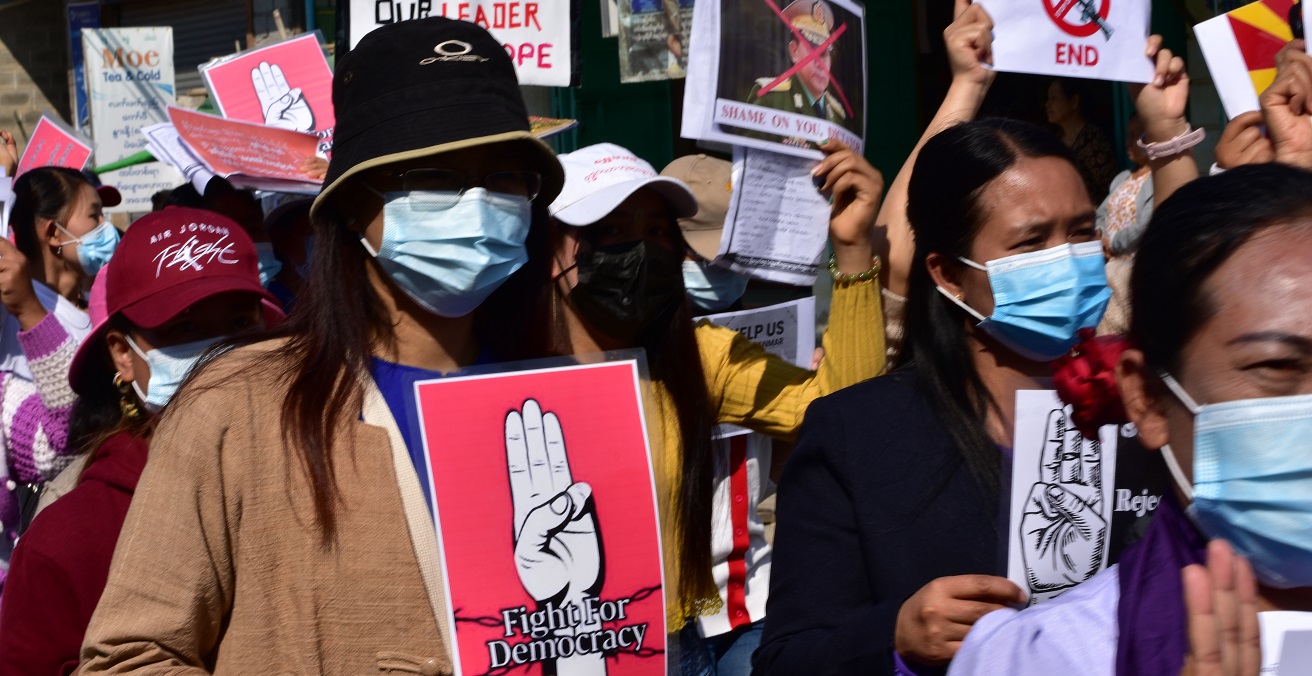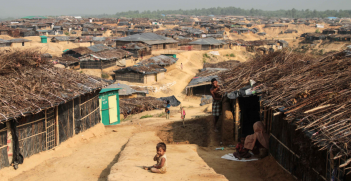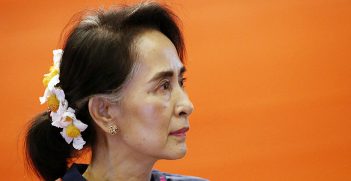Gender on the Front Lines: Protests in Myanmar

In Myanmar, women have shown up in full force, taking to the streets and marching on the front lines – proudly displaying their femininity as a tool of protest. This reflects the nation’s gendered identity, where women are not just fighting for democracy, but their place in political life.
Since the military coup d’etat in Myanmar on 1 February 2021, thousands have taken to the street in protest of the coup, the military, and its leader Min Aung Hlaing. Amidst the thousands gathered, some women and men marched in ball gowns and bare chests. Others carried placards hosting pithy one-liners such as: “My ex is bad. Myanmar military is worse.”
Jessica Trisko Darden’s detailed recount of the ways in which these protesters “are using gender norms” to subvert military authority highlights how gender can be an effective protest and attention-grabbing tool. Taking it one step further, these protest tools can be seen as a manifestation of Myanmar’s gendered national identity. Women represent the nation as makers and defenders of the house and home. Those who stand in rebellion against their traditionally symbolic role do so at grave personal risk and often outright danger.
It has been understood within the feminist international relations community that the conception of the nation can be viewed through a gendered lens to be symbolised by women. This has been viewed metaphorically to demonstrate women acting as markers for their nation, such that their status stands for its progress, rather than their own. Zillah Eisenstein articulated that a nation is but an “imagined community,” a community whereby “women are given no citizen voice, they guard the home and create domesticity, against which men construct their fictive manliness.”
Mother of the nation
Years of the good fight have ensured women have the ways and means to use their “citizen voice” to actively participate in political, and protest, life. Aung San Suu Kyi has indeed used it to great effect. Her path to political power has been built upon the image of one part “the mother of the nation,” a caring matriarch, and one part “democracy icon,” in contrast to the harsh patriarchy of junta rule. The support she has garnered throughout the years has turned her into a cultural symbol, representing the collective Myanmar identity and hopes for what the future will become.
She has become a woman whose image allows for projections of “tradition [to be] debated and reformulated, …where the nation is ‘regenerated,’” but simultaneously, she is a woman who is agentic in “regenerating” the nation toward her idealised path of democracy. Suu Kyi is not fulfilling her domestic role to “guard the home and create domesticity.” Rather, she holds a job in the most public (and masculine) of arenas and has actively defied this symbolic role time and again (even under house arrest). Doing so, however, stands in contravention to the construct of the nation and thus increased public scrutiny and often danger. As women’s bodies are no longer able to create domesticity and the comfort of home, they must be put into their place – the latest manifestation of which came in the form of a military coup d’état.
My nation, my relationship
Despite faltering with the international community, Aung San Suu Kyi’s popularity never wavered at home, with her party, the National League for Democracy (NLD), securing a landslide victory in the recent 2020 election. The latest coup naturally sparked a fierce defence, where many have taken to the streets and pointedly refer to the Tatmadaw – the Myanmar military – as “worse than their ex,” from one young woman’s sign and to another, which read that they “no longer need sex as the military is [screwing] them everyday.”
The explicit references to sex and its power dynamics constitute a symbolic critique of the military, as a historically masculine, heteronormative institution, condemning its heavy-handed deposition of an elected female civilian leader. Women have imaged their own relationships as stand-ins for the nation and its suitors, as a response to the silence of patriarchal power structures towards women’s issues. It positions the Tatmadaw as “controlling partners at best and violent domestic abusers at worst,” highlighting its unrelenting control of the government and its inability to relinquish power and the nation, let alone to a woman.
This woman’s work
Gathering in the thousands, women have shown up to the protests in full force. Some have volunteered as medical aides tending to the wounded and dying. Others have stood beside their fellow unionists representing traditionally female dominated fields of work, or “women’s work,” such as teaching, civil service, fitness instructing, and motherhood.
Others chose to have their femininity on full display. Some dressed up in full Western-style princess ball gowns, or even in their beauty queen regalia – sash and tiara included. At the extreme, some went topless with nothing but body paint.
A single woman’s participation in these protests in and of itself is radical. It stands in direct defiance to the nation’s traditionally symbolic roles ascribed to women, where they were to be invisible, private, and domestic. Therefore, these women are not only protesting their right to democratic nation, but their place in political life. And to lean in even further, they are reclaiming their femininity in these very public and traditionally male-dominated spaces, becoming hyper-visible, as women.
Doing so, however, stands to oppose the current militaristic powers’ attempt to project a (once again) patriarchal image of a nation. When women occupy traditionally masculine spaces and are no longer the creators of domesticity and curators of the home, there are consequences, usually in form of violence and brutalisation. On 9 February, the police shot 19-year-old Mya Thwe Thwe Khaing, and on 3 March, Kyal Sin was shot in the head by security forces.
Participation in political life carries inherent risks, and for women, those risks are exceedingly amplified. Despite this, protests and violent unrest endure. It is the beginning of a long and painful road, and to what end, it is unknown. But women will likely continue to show up every day, not only to fight for democracy, and for their glass ceiling shatterer Aung San Suu Kyi, but also, and most importantly, for a place at the table.
Jin Du is a global health and gender researcher. She recently completed her Masters of International Relations (Adv) where she wrote her thesis on the politics of menstruation in the Pacific. She currently works for the Public Service and is based in Canberra with her ever growing family of plants.
This article is published under a Creative Commons License and may be republished with attribution.





